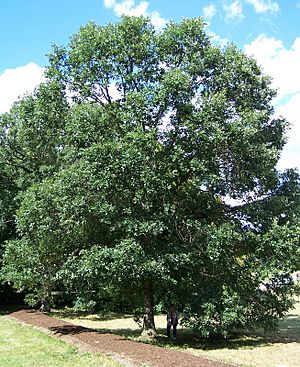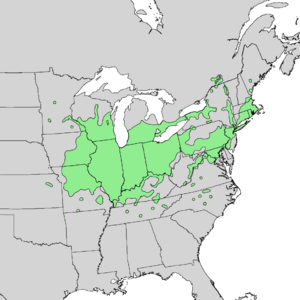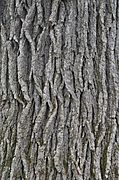Swamp white oak facts for kids
Quick facts for kids Swamp white oak |
|
|---|---|
 |
|
| Morton Arboretum acc. 71-69-2 | |
| Conservation status | |
| Scientific classification | |
| Genus: |
Quercus
|
| Species: |
bicolor
|
 |
|
| Natural range | |
| Synonyms | |
|
List
Quercus bicolor var. angustifolia Dippel
Quercus bicolor var. cuneiformis Dippel Quercus bicolor var. platanoides (Castigl.) A.DC Quercus discolor var. bicolor (Willd.) Hampton Quercus mollis Raf. Quercus paludosa Petz. & G.Kirchn. Quercus platanoides (Castigl) Sudworth Quercus prinus var. bicolor (Willd.) Spach Quercus prinus var. discolor F.Michx Quercus prinus var. platanoides Castigl. Quercus prinus var. tomentosa Michx. Quercus filiformis Muhl. ex A.DC., not validly published Quercus pannosa Bosc ex A.DC., not validly published Quercus platanoides (Lam.) Sudw. Quercus velutina L'Hér. ex A.DC. |
|
The swamp white oak (scientific name: Quercus bicolor) is a medium-sized tree found in North America. It belongs to the beech family, which also includes other oaks. This tree is a common sight in the mixed forests of central and northeastern America. It's known for being able to grow in many different places. Sometimes, it even mixes with the bur oak to create new kinds of trees!
Contents
About the Swamp White Oak
The swamp white oak grows pretty fast. It can reach heights of 60 to 80 feet (about 18 to 24 meters). The tallest known swamp white oak was about 95 feet (29 meters) tall! These trees can live for a very long time, sometimes up to 285 years.
Its bark looks a lot like the bark of the regular white oak. The leaves are wide and oval-shaped. They are usually 5 to 7 inches (12 to 18 cm) long and 3 to 4 inches (7 to 11 cm) wide. The underside of the leaves often has a slightly blue-green color. They have shallow lobes, which are like gentle curves along the edges. In the fall, the leaves turn brown, yellow-brown, or sometimes a reddish color. However, their fall colors are not always as bright as those of the white oak.
The tree produces acorns, which are its fruit. These acorns hang from a stem called a peduncle. They are about 0.6 to 0.8 inches (1.5 to 2 cm) long. Acorns take about six months to grow after the tree is pollinated.
Where Swamp White Oaks Live
Swamp white oaks usually grow alone, not in big groups. You can find them in four main types of forests. These include areas with black ash, American elm, and red maple trees. They also grow where silver maple and American elm trees are common. Sometimes, they are found in forests with bur oak or pin oak and sweetgum trees.
These trees can handle a wide range of temperatures. They grow in places where the average yearly temperature is between 39°F and 61°F (4°C and 16°C). They can survive very hot days, up to 106°F (41°C), and very cold days, down to -29°F (-34°C). The amount of rain they get each year also varies, from 25 to 50 inches (640 to 1270 mm).
Swamp white oaks prefer wet soils, but they don't like places that are always flooded. You'll often see them in wide river valleys, low fields, and along the edges of lakes or ponds. They like similar wet spots as the pin oak, but they are not as common. While pin oaks usually live for about 100 years, swamp white oaks can live much longer, up to 300 years!
Where to Find Them
The swamp white oak is a tree that likes low-lying areas. It grows across the eastern and central parts of the United States and Canada. You can find it from Nova Scotia in Canada down to South Carolina in the U.S. It stretches west to Ontario, Minnesota, and Tennessee. There are also a few small groups of these trees in Nebraska and Alabama.
This tree is most common and grows the biggest in western New York and northern Ohio.
Uses of the Swamp White Oak
The wood from the swamp white oak is very important for making lumber. Its wood is similar to that of the regular white oak. Because of this, lumber companies don't usually tell the difference between them. In recent years, the swamp white oak has become a popular tree for landscaping. This is because it's fairly easy to move and replant.
Like other white oaks, this tree is a favorite for many animals. When its acorns fall in the autumn, animals like deer, bears, turkeys, ducks, and geese come to eat them.
Special Kinds of Swamp White Oaks
There's a special type of oak called 'Nadler' or the Kindred Spirit hybrid oak. It's a mix between a European oak called Quercus robur fastigiata and the swamp white oak.
See also
 In Spanish: Roble bicolor para niños
In Spanish: Roble bicolor para niños




